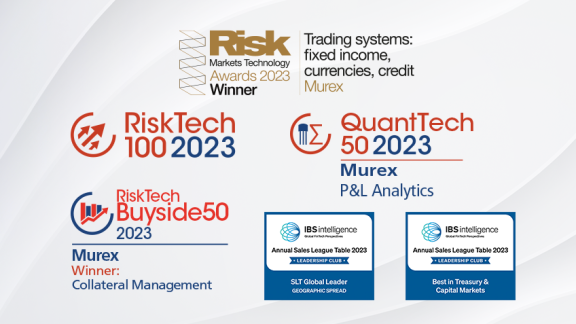-
Our solutions

Vote for us in the following categories:
Vote for us!
20. Best Professional Services Provider
30. Service Provider of the Year
31. Software Solution of the Year- Our clients

With 300 clients and 60,000 users spread across 60 countries around the world, Murex has a truly international client base of capital markets participants.
view all case studies- Insights
- Who we are

Our awards highlight a strong level of customer satisfaction and acknowledge our market expertise.
Visit our awards webpage- Our partners
- Careers
Carbon Trading: Sowing the Seeds for a Greener World

This interview was led by DerivSource editorial staff.
Carbon trading is viewed as one solution to combat climate change, but this niche market faces multiple challenges. In a Q&A with DerivSource, Calvin Ang, senior product manager, commodities, at Murex explores the inner workings of carbon markets and how technology, particularly efficient data management, can help unleash their potential. This interview took place before COP28 and Calvin provided written context following the conference.
Q. How do you define carbon trading and how has it evolved?
A: In the other commodity markets, supply and demand are both driven by willingness of consumers to consume and producers to supply—fulfilling the lower levels of Maslow’s hierarchy of needs (physiological > safety > emotional > esteem > self-actualization)—electricity and natural gas for heating, demand for aviation fuel for travelling. CO2, meanwhile, is an externality, a byproduct of the economies since the Industrial Revolution. The carbon market creates supply and induces the demand of the carbon certificate, as the right to emit CO2, in order to give a price to this externality, its cost. This will act as a price signal for the decision-making of different players (max revenue and/or minimum cost) by taking CO2 emission into account.
Carbon trading is not new. It first appeared in the US as emissions trading or cap and trade in the 1980s as a cost-effective way to curb greenhouse gas emissions. Back then, it was used to phase out lead in petrol, as well as to reduce sulphur dioxide and nitrous oxide emissions to combat acid rain. However, it has gained momentum over the past two decades with regulation—the Kyoto Protocol, adopted in 1997 in COP3, could be viewed as a watershed moment that paved the way for EU ETS deployment—and political will being a driving force in creating eco-awareness, as well as the benefits of carbon trading.
For example, since the Kyoto Protocol, I must say that the Paris Agreement in 2015 (a legally binding international treaty that aimed to limit global warming to 1.5 C), which sharpened the focus on greenhouse gas emissions (GHG) and the damage that they can have, was highly remarkable. It requires all countries to contribute to climate action. Also, the recent floods, fires and unprecedented weather we have been experiencing have also made people realise they can no longer ignore climate change and the impact it is having across the world. The need to protect the Earth has moved down in Maslow’s hierarchy of needs.
Q. How does carbon trading work?
A. Carbon trading is seen as one complementary solution, among others, to combat climate change. There are two main market categories: Compliance and the Voluntary Carbon Market (VCM). The first is where government organisations or regulatory authorities set a limit of CO2 emissions (finite supply) and market players (those covered by the regulation) trade available allowances to meet regulatory targets for a given period. This enables them to emit 1 ton of CO2 per credit, with its associated cost for this externality. Voluntary markets typically trade carbon offsets on a voluntary basis, which allows companies and individuals to compensate for their carbon emissions by buying carbon credits created by projects such as renewable energy that either reduce or remove emissions.
Q. Who are the main players in carbon markets today? What are the different markets they are involved in?
A. Europe is leading the way and introduced the world’s first international emission trading system in 2005. Regulations require large companies covered by the EU ETS (Emissions Trading System), namely power generation and energy intensive industries, to hold an “EU Allowance” or permit for every tonne of emissions. EUA allowances can be acquired either in the primary (auction) or secondary market and companies also receive some allowances for free (with gradual phaseout in the plan). At the end of a given compliance period, the companies will surrender enough allowances to cover their emissions. Companies that fail to surrender sufficient allowances will be subject to noncompliance penalties. The market had a shaky start at the beginning and crashed from €30 to €10 to almost zero in 2006, but policymakers have tightened the rules over the years to make the market as efficient as possible. The result is that prices hit €100 this year.
The EU ETS currently covers about 40 percent of the EU’s GHG and limits emissions from approximately 10,000 installations in the power, manufacturing, oil refinery and commercial aviation sectors in the EU/EEA countries. There is an EU-wide emissions cap, subject to both permanent and ad hoc reductions, applying to the total amount of GHG that can be emitted by in-scope operations. Companies covered by EU ETS and banks are the main players, as per my observation, in this market.
As for other regions, carbon trading is evolving at different stages. For example, in Asia Pacific, there are carbon trading platforms and voluntary domestic initiatives to facilitate the buying and selling of carbon credits in Singapore, Thailand, Hong Kong and Malaysia, Indonesia, Japan and India. We are also seeing some banks going right up the supply chain and financing projects themselves in order to have better oversight on the quality of the generated carbon credits.
Q. What are some of the challenges in the carbon trading market?
A. Data integrity and greenwashing, concerning primarily the VCM, continue to be two of the main challenges and it is an uphill battle to regain market credibility. Inaccurate data, no matter how efficiently delivered or well-integrated, can be misleading. There have recently been critical articles in the press that cite analysis suggesting that many of these offset schemes exaggerate climate benefits and underestimate potential harms. However, the new high-integrity Core Carbon Principles (CCPs) guidelines from the Integrity Council for the Voluntary Carbon Market should help add more certainty and integrity to the market, which in turn would lead to an increase in carbon reduction and removal projects, instead of simply relying on avoidance type of projects.
The CCPs provide a baseline, framework and benchmark for what every carbon credit should have in order to be used as an offset. It has an assessment framework that sets out criteria for carbon-crediting programmes and categories of carbon credits to follow to meet the CCP label. Credits must fund projects that are compatible with a transition to net zero, permanent, additional and robustly quantified. The council will also audit programmes, make spot checks and respond to complaints. If it finds failings, it will be able to suspend or terminate the eligibility of the programme or category.
Q. What role is technology playing in helping to solve these issues?
A. Technology is key. Ensuring the effective management of accurate, high-quality data from various sources and facilitating seamless integration of this data into the existing systems is critical. Market participants need a flexible infrastructure that can source and aggregate data, do calculations such as mark to market (MTM), Value at Risk (VAR) and Profit and Loss (P&L) and manage the data across the entire post-trade life cycle. This includes reconciliations with carbon registries which track offset projects, or renewable power certificates and issue offset credits (or Guarantee of Origin) for each unit of emission reduction or removal that is verified and certified.
Auditing and risk management are critical. There needs to be robust systems in place to ensure that there is no double counting or tampering with the data. They have to be able to measure, monitor and report GHG and ensure there are processes in place that can risk manage price shocks, such as when the war in Ukraine happened and the subsequent impact on energy.
Q. What is your outlook for the future?
A. If you take the compliance markets with EUA and CCA as examples, they are very well regulated and will continue to move forward. As for the voluntary markets, I think it will be a natural evolution towards more compliance rules, more regulation. An example of what can be done is the recent launch of a carbon credit market by the Tokyo Stock Exchange. The government is validating those who are trading on the exchange, which I believe will give more structure and confidence to the market.
I also think that the new CCP guidelines will have a positive impact and lead to more investments into projects that reduce our carbon footprint.
As the dust settles after the COP28, several key outcomes could be drawn from the annual conference. Among them, the one related to Article 6 of the Paris Agreement is deemed the most relevant for carbon trading. In a nutshell, this article sets out the principles for carbon markets in which countries can pursue voluntary cooperation to reach their climate targets. COP28 failed to deliver any progress on Article 6, which is considered as one of the underpinning forces for carbon market development. The absence of a deal fails to provide the highly welcomed momentum to the seemingly frail voluntary carbon market. The discussion will resume in COP29.
To learn more about MX.3 for Carbon Trading, download the brochure.
You might be interested in ...
- Video
Sabine Farhat Discusses Integrated Platform Benefits at ICMA FinTech and Digitalisation Forum
Watch the video- Article
Preparing Clients for LIBOR Discontinuation Scope and Challenges: Part 2 of a Murex Experts Q&A
Read more- Article
Preparing Clients for LIBOR Discontinuation Scope and Challenges: Part 1 of a Murex Experts Q&A
Read more- Video
Murex's Sabine Farhat Highlights Solution to Navigate Changing Securities Finance Landscape
Watch the video- Article
DLT, ISO 20022-style Standardization Power Innovative Services and Operational Efficiency. Here’s How
Read more - Our clients


